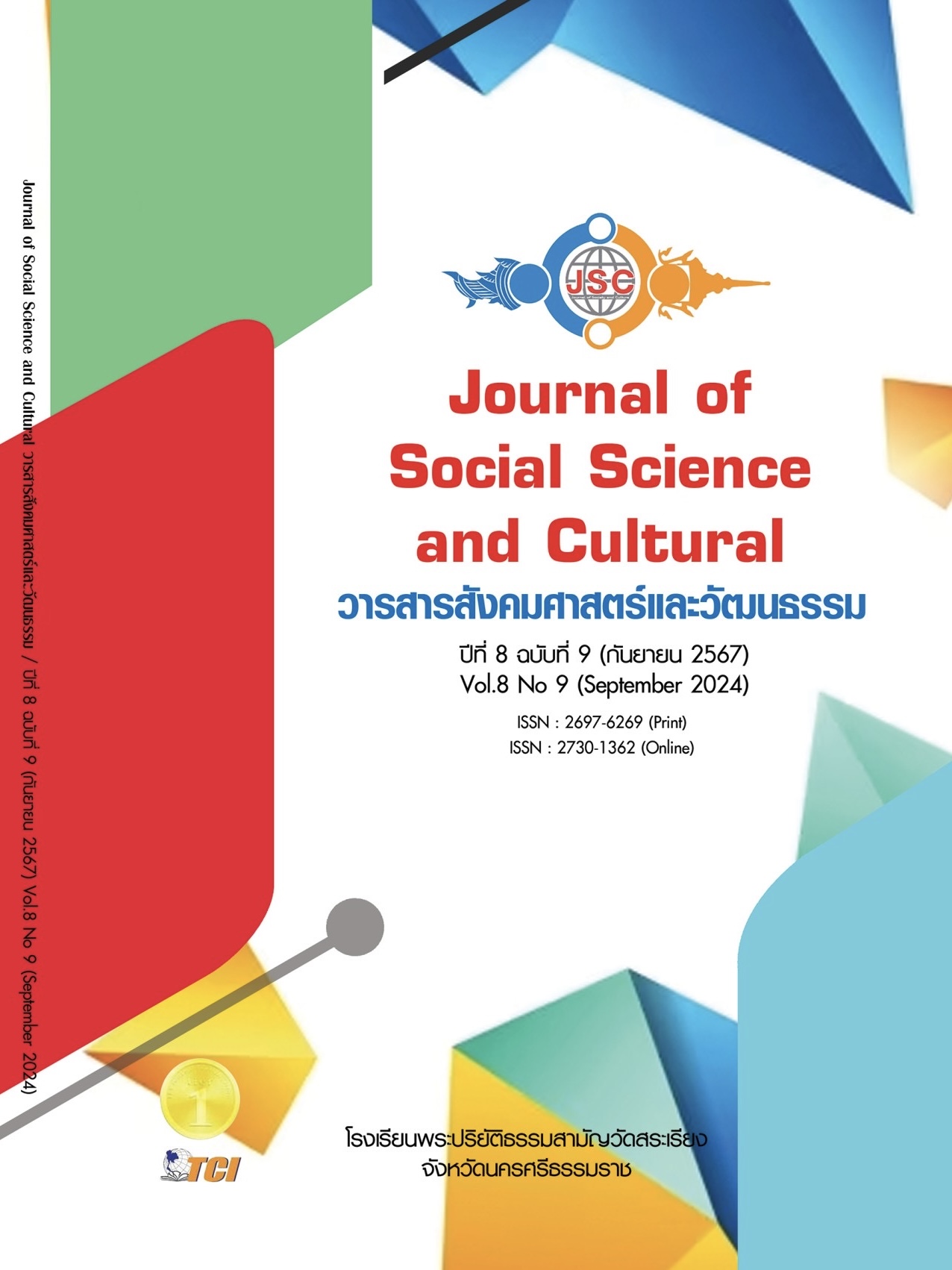COMMUNICATION IN THE MAHACHAT SERMON TO PROMOTE CITIZENSHIP IN DEMOCRACY
Main Article Content
Abstract
The objectives of this research were to study communication to promote democratic citizenship via the Mahachat sermon in terms of 1) content and messages in the sermon; 2) method of presentation; and 3) approaches for improving the messages, content and presentation style to further promote good citizenship in a democracy. This research used the qualitative research method of in-depth interviews. There were 20 key informants, consisting of Buddhist monks who had experience in giving the Mahachat sermon; lay people who had listened to the Mahachat sermon; and academic experts with experience in the fields of communication arts and religion. The key informants were chosen by purposive sampling. The data collection instruments were an in-depth interview form and a focus group discussion form. Data were analyzed by drawing conclusions. The results showed that 1) For content, there were 4 main dimensions: 1.1) in the physical dimension, monks could use the content of the 13th chapter (Nakorngan) to transmit ideas intended to mold listeners’ knowledge, attitudes and behavior to be more fitting for citizens in a democracy; 1.2) in the social dimension, monks could use the content in the first chapter (Tosaporn) to transmit the ideals of responsibility, honesty, and being a law-abiding citizen; 1.3) in the emotional dimension, monks could use content in the second chapter (Himaphan) to transmit conscientiousness about being a Thai citizen, being just, and having a civic sense of self-sacrifice for the common good; and 1.4) in the intellectual dimension, monks could use content in the 6th chapter (Julaphon) to transmit ideas about the importance of analytical thinking, evidence-based rational problem-solving, and participating in politics and administration using only peaceful means. 2) For presentation methods, monks would normally 2.1) start by introducing the audience to the subject by relating the origins of the Mahachat sermon and its story; (2) tell the story using their tone of voice, gestures, and cadence to bring out both the good and bad sides of each character, to arouse listeners’ emotions and encourage them to see the truth and beauty of the dharma teachings, to really enjoy the story while listening, and to gain lessons they can then put to use in their daily lives; 2.3) summarize the lessons, give good take-home conclusions from the tale, and conclude with memorable new definitions and key phrases. 3) For suggestions for improving the content and methods of preaching via the Mahachat sermon to promote citizenship in a democracy, a systematic development plan should be implemented to providing accurate knowledge of Buddhist principles, integrating modern media, and leveraging the role of temples as community centers.
Article Details
References
จันทิมา อังคพณิชกิจ. (2561). การวิเคราะห์ข้อความ. กรุงเทพมหานคร: มหาวิทยาลัยธรรมศาสตร์.
ณัฐนันท์ ศิริเจริญ. (2552). การใช้สื่อบูรณาการเพื่อสร้างความเป็นพลเมืองกับอนาคตประชาธิปไตยไทย. Veridian E-Journal, 5,(1), 150-162.
ถวิลวดี บุรีกุล และรัชวดี แสงมหะหมัด. (2555). ความเป็นพลเมืองในประเทศไทย เผยแพร่ในการประชุมวิชาการสถาบันพระปกเกล้า ครั้งที่ 13. กรุงเทพมหานคร: ศูนย์ประชุมสหประชาชาติ.
ปริญญา เทวานฤมิตรกุล. (2555). การศึกษาเพื่อสร้างพลเมือง พัฒนาการเมืองไทยโดยสร้างประชาธิปไตยที่คน. กรุงเทพมหานคร: นานมีบุ๊คส์.
พงษ์พันธ์ พงษ์โสภา. (2544). จิตวิทยาการศึกษา. กรุงเทพมหานคร: พัฒนาศึกษา.
พชร บัวเพียร. (2537). นิเทศศาสตร์. กรุงเทพมหานคร: บริษัทสกายบุกส์จำกัด.
พระครูวินัยธรมานพ ปาละพันธ์ (กนฺตสีโล). (2553). สืบสานการเทศน์มหาชาติ. กรุงเทพมหานคร: เอดิสัน เพรสโพรดักส์.
พระครูโสภณปริยัตยานุกิจ (อาทิตย์) และคณะ. (2564). ทักษะการใช้ชีวิตในสถานการณ์โควิด 19 ตามหลักพุทธจิตวิทยา. วารสาร มจร มนุษยศาสตร์ปริทรรศน์, 7(2), 399-411.
พระมหาโพธิวงศาจารย์. (2563). วิถีชีวิตใหม่ New Normal. เรียกใช้เมื่อ 10 กรกฎาคม 2564 จาก https://siamrath.co.th/n/166631
พระราชธรรมวาที (ชัยวัฒน์ ธมมวฑฒโณ). (2549). ลีลาวาทีธรรม. กรุงเทพมหานคร: ธรรมสภา.
พระอัครเดช ญาณเตโช (โลภะผล). (2557). พุทธปรัชญาการศึกษา. วารสารอิเล็กทรอนิกส์การเรียนรู้ทางไกลเชิงนวัตกรรม, 4(2), 49-62.
มหาจุฬาลงกรณราชวิทยาลัย. (2539). พระไตรปิฎกฉบับภาษาไทย ฉบับมหาจุฬาลงกรณราชวิทยาลัย. กรุงเทพมหานคร: โรงพิมพ์มหาจุฬาลงกรณราชวิทยาลัย.
รัชเกล้า กองแก้ว. (2559). ความเป็นพลเมืองไทย: แนวคิดพื้นฐานในการขับเคลื่อนสังคม ในหลักสูตรการปกครองกันราชอาณาจักรุ่นที่ 59 ประจำปีการศึกษา พุทธศักราช 2559-2560. กรุงเทพมหานคร: สถาบันวิชาการครองกันประเทศ.
วรากรณ์ สามโกเศศ. (21 เมษายน 2564). “การจัดการศึกษาเพื่อสร้างความเป็นพลเมืองในประชาคมอาเซียน.”. มติชน, หน้า 2.
สถาบันพระปกเกล้า. (2555). ความเป็นพลเมืองกับอนาคตประชาธิปไตยไทย ใน เอกสารประกอบการประชุมวิชาการสถาบันพระปกเกล้า ครั้งที่ 13 ประจำปี 2554 เล่ม 2. กรุงเทพมหานคร: สถาบันพระปกเกล้า.
สายชล สัตยานุรักษ์. (2555). วิถีไทยกับการเสริมสร้างความเป็นพลเมืองไท. ใน สรุปการประชุมวิชาการสถาบันพระปกเกล้า ครั้งที่ 13 เรื่อง ความเป็นพลเมืองกับอนาคตประชาธิปไตยไทย. กรุงเทพมหานคร: สถาบันพระปกเกล้า.
สำนักงานเลขาธิการสภาผู้แทนราษฎร. (2558). ความเป็นพลเมืองในระบอบประชาธิปไตย. กรุงเทพมหานคร: สำนักการพิมพ์สำนักงานเลขาธิการสภาผู้แทนราษฎร.
เสฐียร พันธรังษี. (2516). ศาสนาเปรียบเทียบ. กรุงเทพมหานคร: ผดุงวิทยาการพิมพ์.
องค์การเผยแผ่วัดประยุรวงศาวาส. (2548). ศิลปะการเทศนา. กรุงเทพมหานคร: หจก.สามลดา.
องค์การเผยแผ่วัดประยุรวงศาวาส. (2549). วิชาการเทศนา. กรุงเทพมหานคร: หจก.สามลดา.
อเนก เหล่าธรรมทัศน์. (2554). การเมืองภาคพลเมือง. (พิมพ์ครั้งที่ 3). กรุงเทพมหานคร: สำนักประชาสัมพันธ์ สำนักงานเลขาธิการสภาผู้แทนราษฎร.
อภิชาติ ดำดี. (2549). หลักพระพุทธศาสนากับการส่งเสริมวิถีชีวิตประชาธิปไตย. กรุงเทพมหานคร: ศูนย์การพิมพ์แก่นจันทร์.
อรวรรณ ปิลันธน์โอวาท. (2549). การสื่อสารเพื่อการโน้มน้าวใจ. กรุงเทพมหานคร: สำนักพิมพ์แห่งจุฬาลงกรณ์มหาวิทยาลัย.
อุบลวรรณ เปรมศรีรัตน์. (2558). การเล่าเรื่องทางนิเทศศาสตร์: ศึกษาจากงานวิจัย. วารสารนิเทศศาสตร์และนวัตกรรม นิด้า, 2(1), 31-58.
Clevenger, T. J. R. (1959). A synthesis of experimental research in stage fright. Quarterly journal of speech, 45(1), 134-145.
Dominick, J. R. (2005). Dynamics of mass communication: Media in the digital age. (8th ed.). Boston: MA: McGraw-Hill.
Jantawan, N. (2016). Democratic Citizenship: A Case Study of Undergraduates at the Main Campus of Ramkhamhaeng University. Academic Journal Phranakhon Rajabhat University, 7(1), 103-113.
Jensantikul, N. (2013). Social structure, role and public policy with the citizenship. Journal of Liberal Arts Prince of Songkla University Hat Yai, 5(1), 49-62.
Tubbs, S. L. & Moss, S. (2000). Human communication. Boston: MA: McGraw-Hill.


